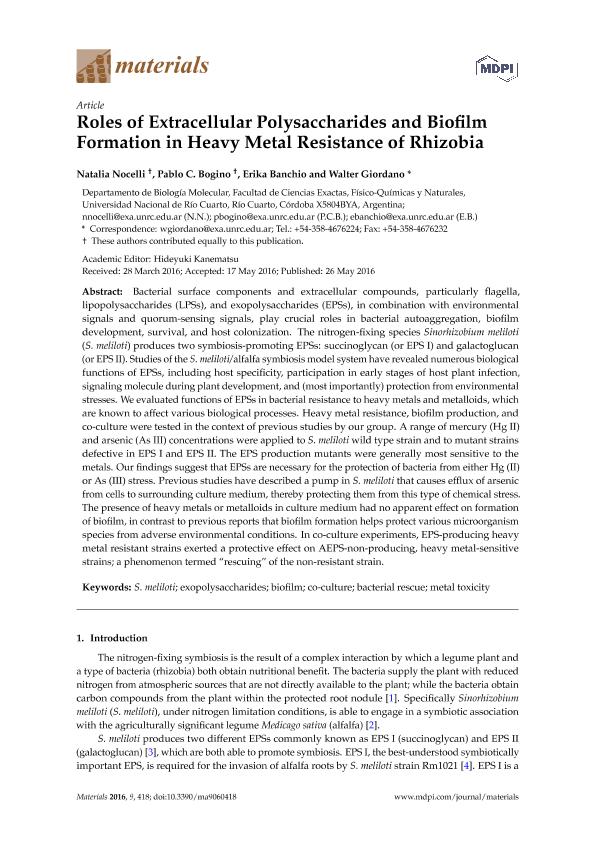Artículo
Roles of extracellular polysaccharides and biofilm formation in heavy metal resistance of rhizobia
Fecha de publicación:
05/2016
Editorial:
Multidisciplinary Digital Publishing Institute
Revista:
Materials
ISSN:
1996-1944
Idioma:
Inglés
Tipo de recurso:
Artículo publicado
Clasificación temática:
Resumen
Bacterial surface components and extracellular compounds, particularly flagella, lipopolysaccharides (LPSs), and exopolysaccharides (EPSs), in combination with environmental signals and quorum-sensing signals, play crucial roles in bacterial autoaggregation, biofilm development, survival, and host colonization. The nitrogen-fixing species Sinorhizobium meliloti (S. meliloti) produces two symbiosis-promoting EPSs: succinoglycan (or EPS I) and galactoglucan (or EPS II). Studies of the S. meliloti/alfalfa symbiosis model system have revealed numerous biological functions of EPSs, including host specificity, participation in early stages of host plant infection, signaling molecule during plant development, and (most importantly) protection from environmental stresses. We evaluated functions of EPSs in bacterial resistance to heavy metals and metalloids, which are known to affect various biological processes. Heavy metal resistance, biofilm production, and co-culture were tested in the context of previous studies by our group. A range of mercury (Hg II) and arsenic (As III) concentrations were applied to S. meliloti wild type strain and to mutant strains defective in EPS I and EPS II. The EPS production mutants were generally most sensitive to the metals. Our findings suggest that EPSs are necessary for the protection of bacteria from either Hg (II) or As (III) stress. Previous studies have described a pump in S. meliloti that causes efflux of arsenic from cells to surrounding culture medium, thereby protecting them from this type of chemical stress. The presence of heavy metals or metalloids in culture medium had no apparent effect on formation of biofilm, in contrast to previous reports that biofilm formation helps protect various microorganism species from adverse environmental conditions. In co-culture experiments, EPS-producing heavy metal resistant strains exerted a protective effect on AEPS-non-producing, heavy metal-sensitive strains; a phenomenon termed “rescuing” of the non-resistant strain.
Archivos asociados
Licencia
Identificadores
Colecciones
Articulos(CCT - CORDOBA)
Articulos de CTRO.CIENTIFICO TECNOL.CONICET - CORDOBA
Articulos de CTRO.CIENTIFICO TECNOL.CONICET - CORDOBA
Citación
Nocelli, Natalia Estefanía; Bogino, Pablo Cesar; Banchio, Erika; Giordano, Walter Fabian; Roles of extracellular polysaccharides and biofilm formation in heavy metal resistance of rhizobia; Multidisciplinary Digital Publishing Institute; Materials; 9; 6; 5-2016; 1-19
Compartir
Altmétricas




